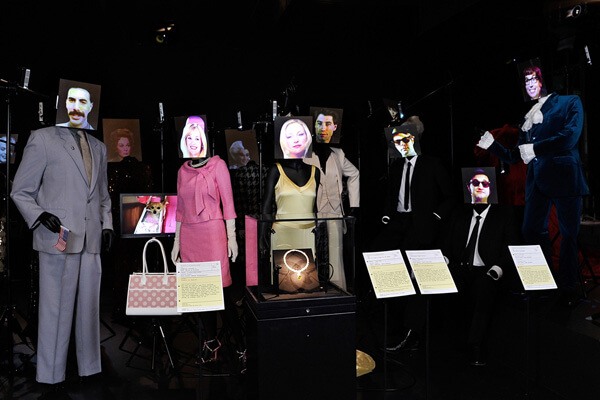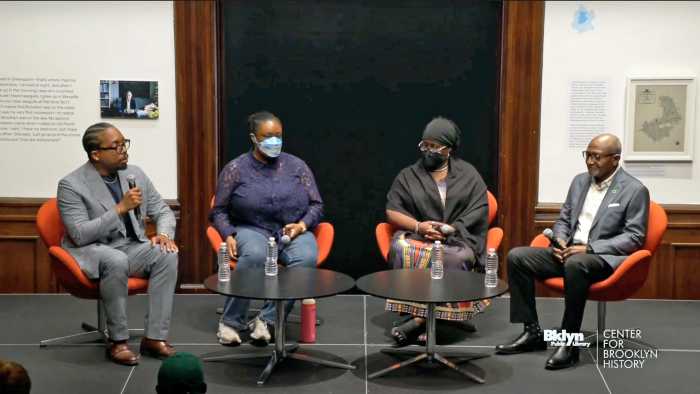Dexter Fletcher as a young Caravaggio in Derek Jarman’s 1986 film. | BRITISH FILM INSTITUTE/ PHOTOFEST
BY GARY M. KRAMER | The late, great gay filmmaker Derek Jarman made enduring contributions to cinema. His final theatrical release, “Blue” (Nov. 7, 7:30 p.m.) in 1993, was an extraordinary experimental documentary about his life with HIV. Jarman shot a single composition of a blue screen while in voice-over he describes his thoughts about life and death. The static image is a symbol of his sightlessness — AIDS had destroyed his retinas.
This may sound like a rigorous approach to presenting film — and at points, it feel that way — but Jarman’s poetic narrative, full of beautiful imagery, stream of consciousness candor, and justified outrage, creates a powerful, revealing self-portrait. “Blue” is full of fascinating insights, as when Jarman equates his hospital with an S&M club, where everyone is anonymous. This is an appropriate, elegiac last film.
Jarman died in 1994, and now, on the 20th anniversary year of his passing, BAMcinématek is presenting a “comprehensive retrospective” of the director’s work. In addition to his dozen feature films, Jarman’s shorts, videos (for the Smiths and Throbbing Gristle, among others), and documentaries will be shown along with Ken Russell’s 1971 film “The Devils” (Oct. 31, 2, 4:30, 7 & 9:30 p.m.), for which Jarman designed the sets.
BAM celebrates the transgressive queer riot of Derek Jarman’s cinema
Two of the highlights of Jarman’s career, “Sebastiane” and “Caravaggio” will be shown in new digitally restored versions. “Sebastiane” (Nov. 9, 2 & 6:30 p.m.), from 1976, at first blush might seem pretentious. It features an all-male, mostly nude cast speaking Latin, but the film is, in fact, a masterpiece of historic importance in queer cinema. The filmmaker’s decadent vision is what makes this daring film so memorable.
Set in 303 AD, “Sebastiane” features a group of able-bodied Roman soldiers in exile. The title character (Leonardo Treviglio), believed to be a Christian, disobeys the orders of his commanding officer and is repeatedly punished. Still, he still fascinates the men, who alternately befriend and fight with him — until he is martyred in a scene that is at once violent and erotic.
Throughout the film, Jarman clearly enjoys fetishizing Treviglio, and the sexual tension that exists as Sebastiane is spied while showering or tied down in the desert is palpable. A sequence in which two soldiers make love in slow motion in the water and one where the men unwind in the bath are highlights.
Jarman’s 1986 feature “Caravaggio” (Nov. 8, 4:30, 7 & 9:15 p.m.) is arguably the director’s best film. Less a biopic of the painter than a tableau of episodes in his life, the story flashes back and forth in time as Caravaggio (Nigel Terry) lies on his deathbed. Early on, he screams out the name “Ranuccio” (Sean Bean), who is revealed to be a model who inspired the artist and whom the artist loved, perhaps unrequitedly.
We see Ranuccio knife Caravaggio (as a young man, Dexter Fletcher), after which the men become blood brothers. The fragile relationship among them and Ranuccio’s lover Lena (Tilda Swinton, Jarman’s muse, in her film debut) forms much of the film’s drama.
But other narratives emerge as well, such as Caravaggio’s early work as a painter and his relationship with Cardinal del Monte (Michael Gough), who sponsored his work. These scenes provide Jarman with opportunities to explore themes including Caravaggio’s homosexuality and the corruption of the Catholic Church.
Like most of Jarman’s work, “Caravaggio” is more concerned with mood and atmosphere than narrative and realism. Jarman’s painterly use of light and mirrors creates fabulous imagery, and the representations of the artist’s paintings — including a self-portrait as Bacchus — are beautifully rendered. There are also fabulous period costumes by Sandy Powell. The film includes anachronistic moments, such as one of a critic typing his review of the artist’s work in his bathtub — scenes that amuse rather than perplex.
“Caravaggio” was one of several “portraits” the filmmaker made over his career. “Wittgenstein” (Nov. 9, 4:15 & 8:45 p.m.), from 1993, is another, and it is also a highly stylized tableau. Jarman shrewdly stages the philosopher’s life in a series of dioramas all shot against a black background or, in some cases, a blackboard. The minimalist approach has maximum impact. Again, the director’s use of light and color pop on the screen.
In direct address to the camera, the young Ludwig Wittgenstein (Clancy Chassay) tells his life story, presenting his family but also expostulating about a variety of theories of logic. He also interacts with a green Martian (Nabil Shaban), which is better than it sounds.
Jarman presents many of Wittgenstein’s thoughts via episodes in the thinker’s life, such as his enlisting in war, publishing a book (for no money or royalties), and his efforts and frustrations teaching at Cambridge and elsewhere. Sexuality is treated matter-of-factly in the film, with scenes of Wittgenstein holding the hand of Johnny (Kevin Collins) in the cinema and sharing a bed with him. Jarman ends his playful production on an appropriately witty note that will delight viewers.
Other treasures are revealed by going deep into the director’s backlist. Jarman’s 1985 feature “The Angelic Conversation” (Nov. 4, 7 & 9:15 p.m.) is a series of beautiful, mostly stop-motion images shot on Super-8 and blown up to 35mm. There is no narrative, only Judi Dench reciting Shakespeare’s love sonnets as two handsome young men (Paul Reynolds and Phillip Williamson) enact a “romance.” The hypnotic musical soundtrack is provided by the band Coil.
Jarman’s artistic use of light is incandescent here. Some sequences burst with color or are filmed in arty black and white, providing a visual texture to Dench’s regal voice-over. “The Angelic Conversation” is representative of Jarman’s many films made using Super-8. Of all his work, it is also the filmmaker’s favorite.
Steven Waddington and Kevin Collins in Derek Jarman’s “Edward II.” | FINE LINE FEATURES/ PHOTOFEST
“Queer Pagan Punk” also showcases films that allowed Jarman to put his queer spin on other works drawn from popular culture: “The Tempest” (Nov. 1, 7 & 9:15 p.m.) was a wildly inventive 1979 take on Shakespeare; 1991’s “Edward II” (Nov. 2, 4, 6:15 & 8 p.m.) retells Christopher Marlowe’s drama about the 14th century king, complete with scenes of contemporary queer protesters; and his contribution to the 1987 omnibus “Aria” (Nov. 10, 7 & 9:15 p.m.) features Tilda Swinton in a re-imagining of Charpentier’s “Louise.” “War Requiem” (Nov. 6, 7 & 9:15 p.m.), from 1988, provides a kaleidoscopic visual essay set to Benjamin Britten’s music.
There is more — much more — most notably “The Last of England” (Nov. 5, 7 & 9:15 p.m.), Jarman’s 1988 attack on Margaret Thatcher. The non-narrative film is a riot of color and style, with Jarman’s 8mm home movies intercut between mesmerizing images of soldiers and a great gay sex scene that happens on top of a British flag.
I hope this retrospective prompts a renewed passion as well as a re-evaluation of Jarman’s indelible work, which remains spellbinding two decades after the filmmaker’s death.
QUEER PAGAN PUNK: THE FILMS OF DEREK JARMAN | BAMcinématek , BAM Rose Cinemas, 30 Lafayette Ave. at St. Felix St. | Oct. 30-Nov. 11 | Schedule, tickets at bam.org




































